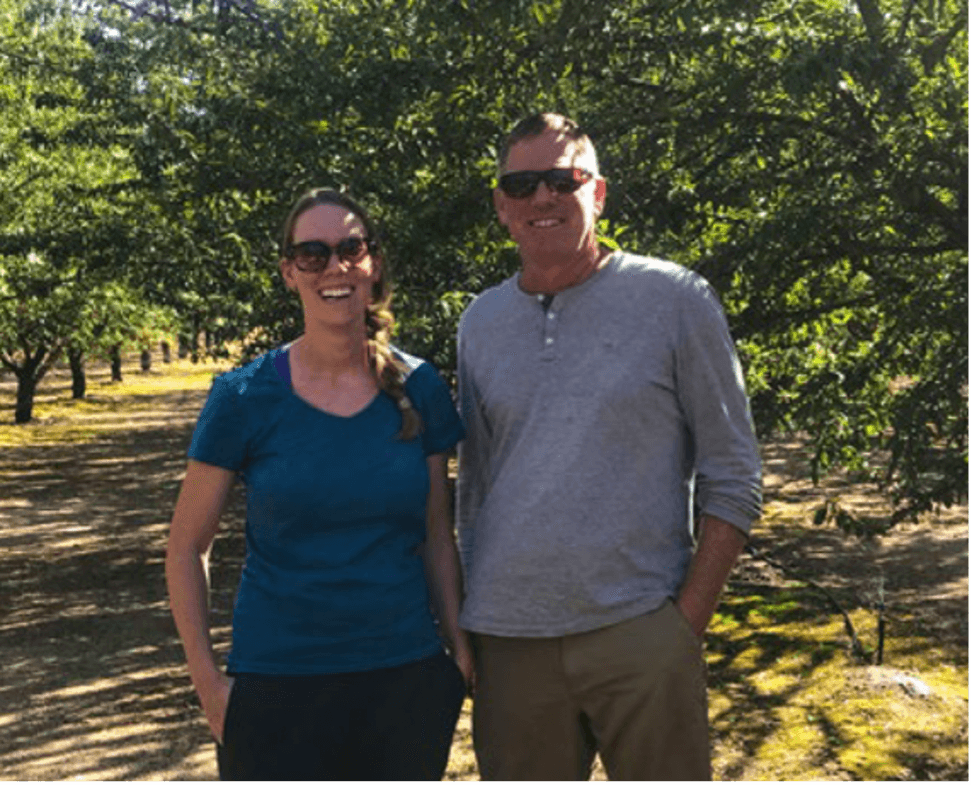Based on a feature in American Farmland Trust’s Soil Health Bottom Line Program – full article available here.
Introduction
Rich Gemperle and his family grow almonds on 1,500 acres in Stanislaus County, California. The land consists primarily of sandy loam soils on flat terrain, and some acreage has been in the family for 60 years. Gemperle Farms is recognized as a leader in sustainable farming methods. As a result of adopting healthy soil practices, including use of Switzerland’s AQUA4D® precision irrigation technology, Gemperle has observed improved water infiltration and water holding capacity, more beneficial insects, less soil compaction, and overall improved soil tilth.
Precision Irrigation
Rich strives to irrigate precisely to meet the crop water demand and avoid overirrigation and leaching into groundwater. Most of the orchards have micro-sprinkler irrigation systems, and Rich utilizes soil moisture sensors, evaporation rates, and distribution uniformity tests to help guide his irrigation scheduling. Since 2019 he has also utilized AQUA4D® water treatment to good effect, helping solve salinity issues while conserving water.
“We’ve seen an astonishing difference in our water penetration” – Rich Gemperle interview
Rich credits his father and uncle for instilling a passion and sense of purpose for regenerative farming. Walter Gemperle farmed with an “old country” philosophy of building soil health and reducing reliance on heavy usage of fertilizers and pesticides. As Rich explains, “We consider how everything we do in the orchard affects the soil and the health of the trees. Since we farm with coarse soils, we do a lot of work to keep the soil alive. Our program of cover cropping and composting is well worth the effort, and we are seeing numerous benefits, especially better tree vigor, reduced costs, and increases in yield.”
Balancing Stewardship, Crop Production, and Costs
This study focuses on a 67-acre block where Rich and Tanya adopted healthy soil practices in 2016. At that time, they were experiencing soil compaction problems and poor water infiltration. They planted cover crops, added compost, and applied new-generation micro-nutrient fertilizers. Through these practices, the Gemperles saw an increase in soil organic matter content, a decrease in production costs, and an increase in yields by 18% over the past seven years. Rich attributes 50% of the yield gains to healthier soils and 50% to improved irrigation management.
“With the AQUA4D we immediately saw a change and we coupled it with the gypsum and we just have great water penetration now,” Gemperle observed. “It’s a huge difference – the irrigators are saying there are completely different dynamics going on out here.”
Meanwhile, cover cropping increases soil microbial biomass and activity, soil organic matter content, water retention, and improves aeration. In addition, Rich and Tanya report better water infiltration, beneficial insect habitats, weed suppression, less dust, greater bee activity, and earlier access to the orchard after rains. Rich applies 4 tons per acre of composted chicken manure, sourced from the family’s egg business. The compost benefit to soil health allowed Rich to reduce applications of fertilizers and still meet the crop nutrient demand. The AQUA4D® system’s efficient dissolution of minerals in irrigation water further boosts nutrient uptake and fertilizer efficiency.
Rich Gemperle and AQUA4D’s Charles-Henri Faure in the Central Valley
Financial benefits
Cost reductions occurred when Rich and Tanya began adopting healthy soil practices. Herbicide and insecticide use decreased by over 50%, and the cost of nitrogen fertilizers and potash were reduced due to the combined benefit from compost, cover crops, and most recently through the use of high efficiency precision irrigation. For the 67-acre study area, a reduction in production costs of $116 per acre was observed. The increased revenue is due to gains in almond yields. Crop proceeds increased by $309 per acre. In total, the Gemperles improved their bottom line by $425 per acre, or $28,475 for the 67-acre block.
Water Quality and Carbon Sequestration
The USDA’s Nutrient Tracking Tool (NTT) was used to calculate the water quality benefit due to Rich’s farming practices. Soil and farm input data, such as fertilizer and water use, were collected. These values show a significant benefit to soil and water quality, documenting potential decreases in nitrogen leaching and soil erosion, and an improvement in nutrient availability. USDA’s COMET-Planner tool estimates carbon sequestration and the reduction in greenhouse emissions from regenerative farming practices. Information from cover cropping, compost, nutrient management, and soil types were entered into the tool. COMET-Planner found a reduction in greenhouse emissions and the sequestering of carbon equal to 403 CO2 equivalent, or 6,660 tree seedlings grown for ten years.
Final Thoughts
Rich and his family’s passion for stewardship of their land is demonstrated by their multi-generational approach to farming. Rich says that his farming practices continue to evolve as he learns about the best methods to manage his orchards. “We want to grow our trees on living soils that are healthy from year to year. With three generations on the land, we try to farm in ways that sustain the soil over time, sequester carbon, and benefit the environment.”
Video: Jeff Nunes surveys the effect of precision irrigation on Central Valley nut trees
California
Soil Health
Precision Irrigation
“Rich attributes 50% of the yield gains to healthier soils and 50% to improved irrigation management.” – American Farmland Trust
About the American Farmland Trust:
AFT’s Soil Health Bottom Line Program supports on-farm research that showcases the economic and environmental benefits of using soil health practices.





